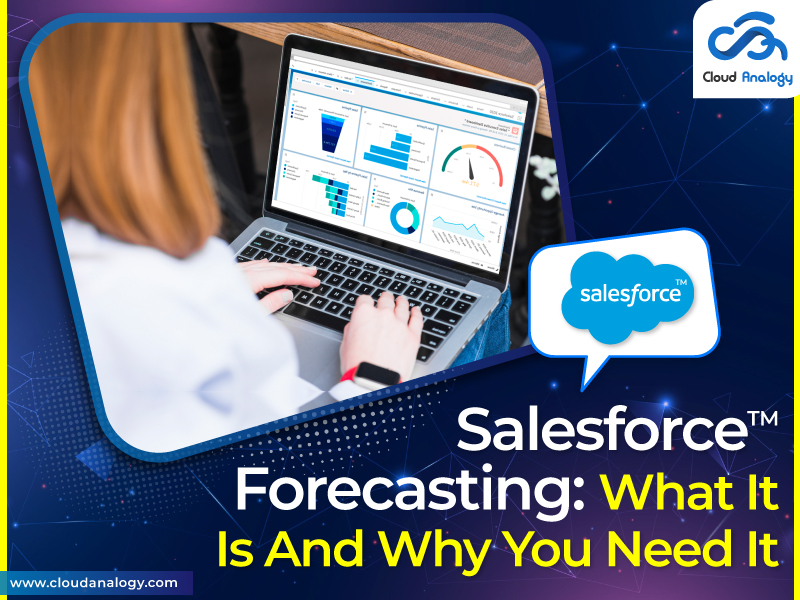Sharing is caring!
Forecasting the future is one of the most effective ways of predicting revenue. It is difficult to overstate the necessity of forecasting for a company that wants to generate high sales in a particular year. And hiring the top Salesforce consulting firm can help you accelerate your path by assisting you in implementing forecasting in Salesforce.
When it comes to Salesforce, factors such as forecast type, adjustments, time, and currency determine the forecast amount. Salesforce forecasting plays a vital role in your business. The more accurate your forecast, the more impactful it becomes. Not just this, Salesforce forecasting allows the sales team to predict and plan their sales cycle from the pipeline. Sales forecasting helps organizations to gain confidence in their services, and accurate sales forecasting allows business leaders to thrive and flourish in the competitive industry.
In this guide, you will be getting acquainted with everything you need to know about Salesforce forecasting. To keep up with your company’s projected sales and maintain everyone’s expectations on track, Salesforce forecasting is crucial.
Before getting started with the benefits of Salesforce Forecasting and how to create a forecast in Salesforce, let’s understand what sales forecasting is and why it is essential for a business.
What Is Sales Forecasting?
Sales forecasting is a projection of expected sales revenue. It estimates the number of sales a company is going to make within a stipulated time frame. Sales forecasts depend on the inputs. They may rely on artificial intelligence (AI) or the intuition of the company’s sales reps. But all sales forecasts incline on two major questions – how much and when. Each sales opportunity comes with its own projected amount of sales. The sales team has to predict one specific amount of sales for that particular year. Also, sales forecasts can be determined by a month, quarter, or year.
Benefits Of Salesforce Forecasting
Every business bears different objectives and challenges. Consequently, salesforce forecasting will impact each in different ways. Here are some significant benefits of salesforce forecasting.
- Helps in comparing sales to expectations and assists in altering the methods accordingly.
- Allows you to identify potential problems and will allow you to resolve them.
- Predicts new sales opportunities to assist you in making insightful business decisions.
- Boosts your sales team productivity and allows them to discover efficient sales strategies.
What Are Other Factors Crucial While Sales Forecasting?
The sales forecast provides answers to the following questions:
What: Projections should be based on what services the company plans to offer. It can even be about the issues your leads face and what steps you take to resolve them.
Where: Here, you need to answer where the products will be used. Your sales team can visit the particular location or lead and get their answers.
Who: You must be well-aware of the fact of who your prospects or potential customers are. Depending on that, you can take the final call.
How: An organization must overlook their customers’ purchasing decisions and understand how they used to buy in the past and how they are doing it now.
Why: You must recognize why a customer is considering purchasing from you and why they are not chasing your competitors.
Types Of Forecasting In Salesforce
Pipeline Forecasting: Pipeline forecasting, often confused with pipeline management, estimates sales performance according to the essential data. It assists the sales representative to close more successful deals and acquire sales quotas. Such forecasting in Salesforce does not have a considerable impact on sales, but it can assist your business in accurately estimating sales volumes.
Customizable Forecasting: It is a flexible solution for assessing the total revenue of the company. Customizable forecasting lets you know the number of things your company sells. It is one of the ideal approaches for predicting the revenue the organization will create from sales. In addition, this kind of forecasting in Salesforce is dependent on the date ranges you select, whether those are quarterly or monthly.
How To Set Up Forecasting In Salesforce?
1. Go to the Quick Find box, enter and select Forecasts (Customizable).
2. Select the Edit Forecast setting for your company. This tool will determine items based on date start, range, and more by customizing the default setting for your organization.
3. After you have customized your settings, tap Batch submit forecast for the users. Now you will choose your forecast period and the clients whose forecast you would like to submit.
4. Now, select Set up on the forecasting ranking of your organization. Before this step, ensure that all your clients are mentioned in the hierarchy. If not, then you can go to Enable Users for Customizable Forecasting and add them.
Bottom Line
The main attribute of sales forecasting is to provide a certain number of sales the company will make. However, uncertain times, such as a global pandemic, extreme weather conditions, disastrous calamities, might crash your predictions. One must have a plan B that will help you survive the harsh conditions. After all, selling has become more complex than ever before, so forecasting your sales would prove to be of great assistance.
Need guidance or assistance in getting started with Salesforce Forecasting? Contact Cloud Analogy, a leading Salesforce Consulting Company, that can help you get the most of your Salesforce investment and maximize your business profitability.

Deepali Kulshrestha
Salesforce Certified Developer | Delivery Management Head
Deepali, a certified Salesforce Advanced Administrator and Salesforce Developer and CSPO Certified at Cloud Analogy, is a successful name in the industry circles when it comes to the delivery of successful projects with end-to-end testing. Deepali is a globally-renowned industry stalwart when it comes to managing Operations & Delivery Planning in driving Business Performance Management.Hire the best Salesforce Development Company. Choose certified Salesforce Developers from Cloud Analogy now.










